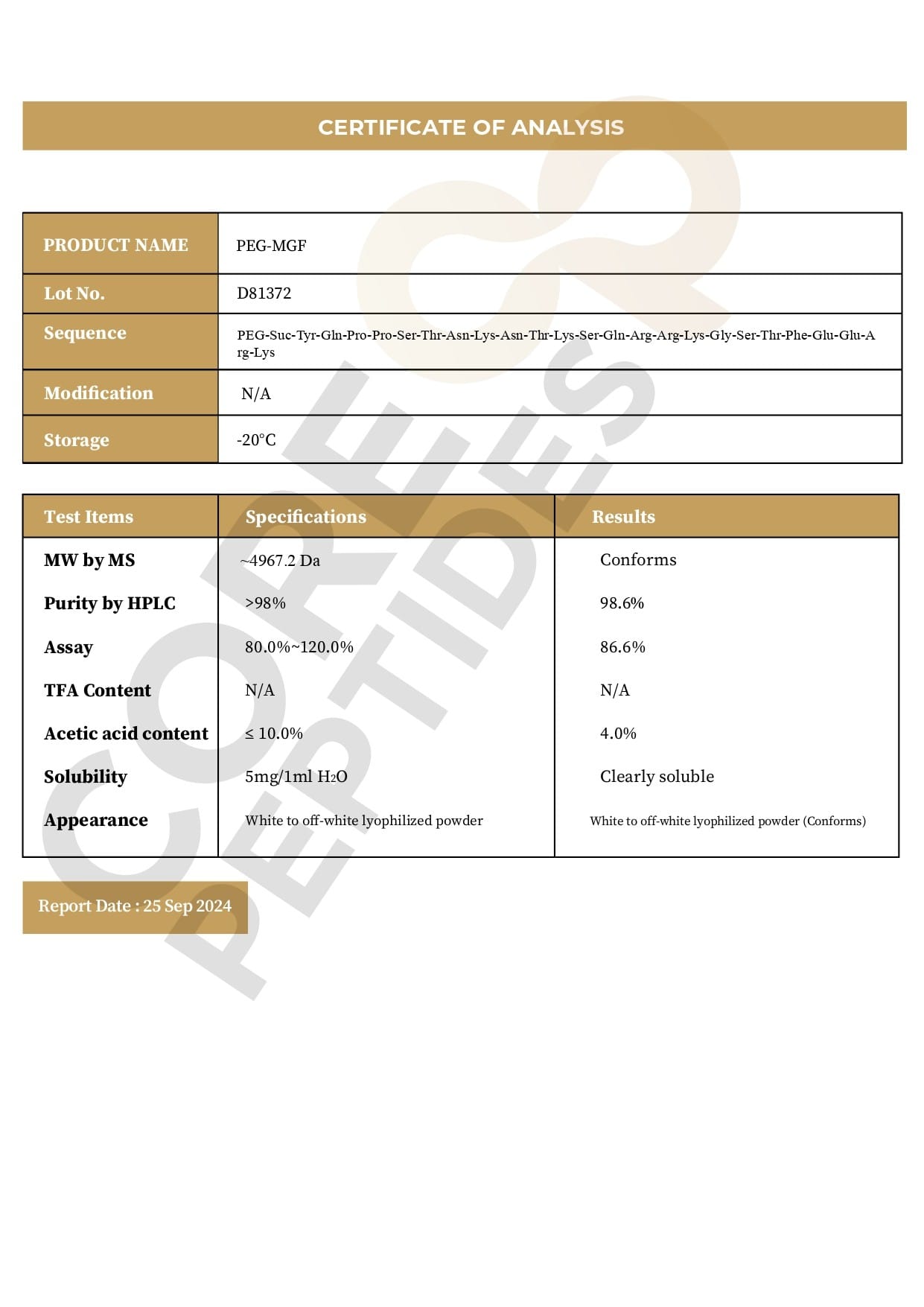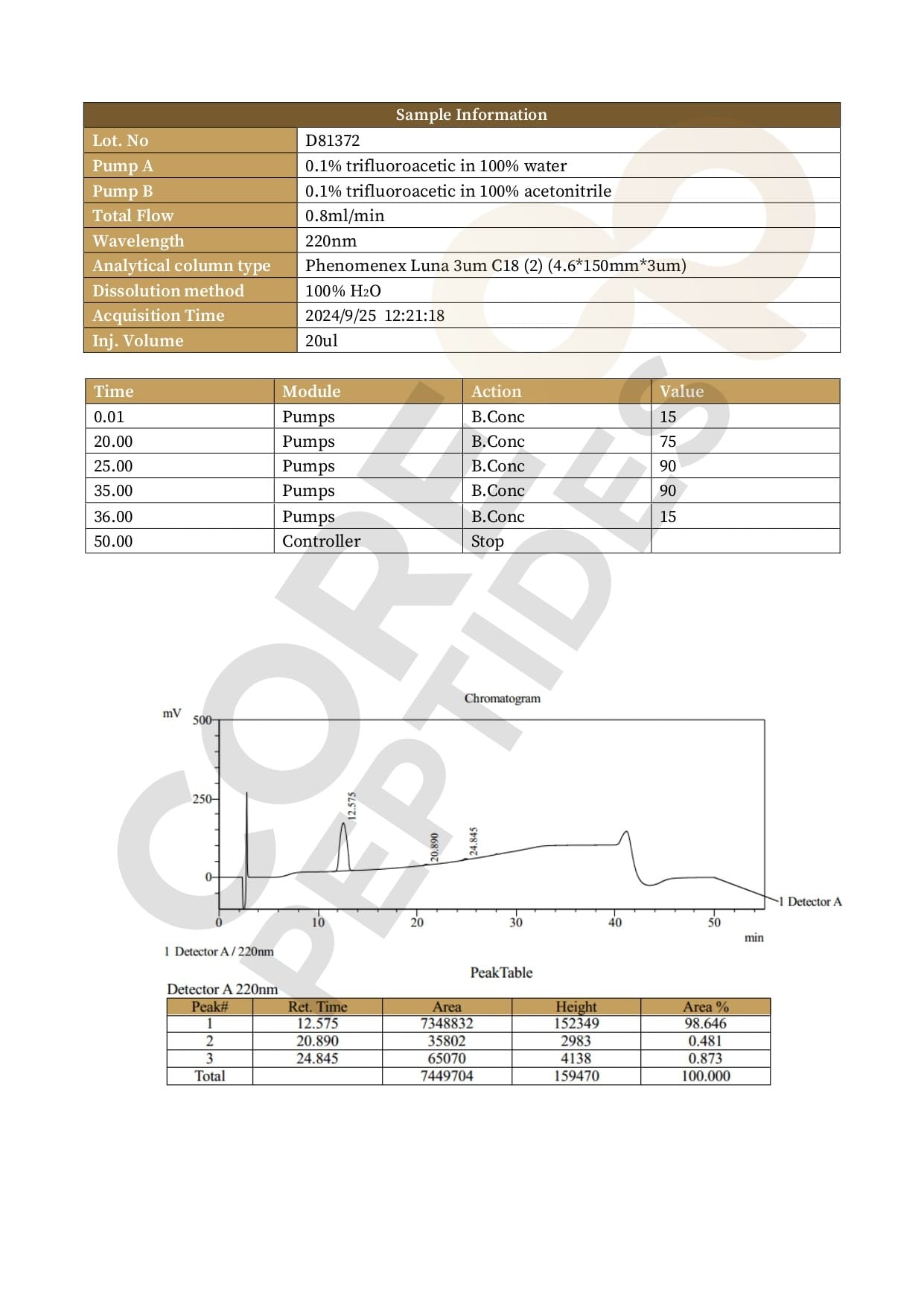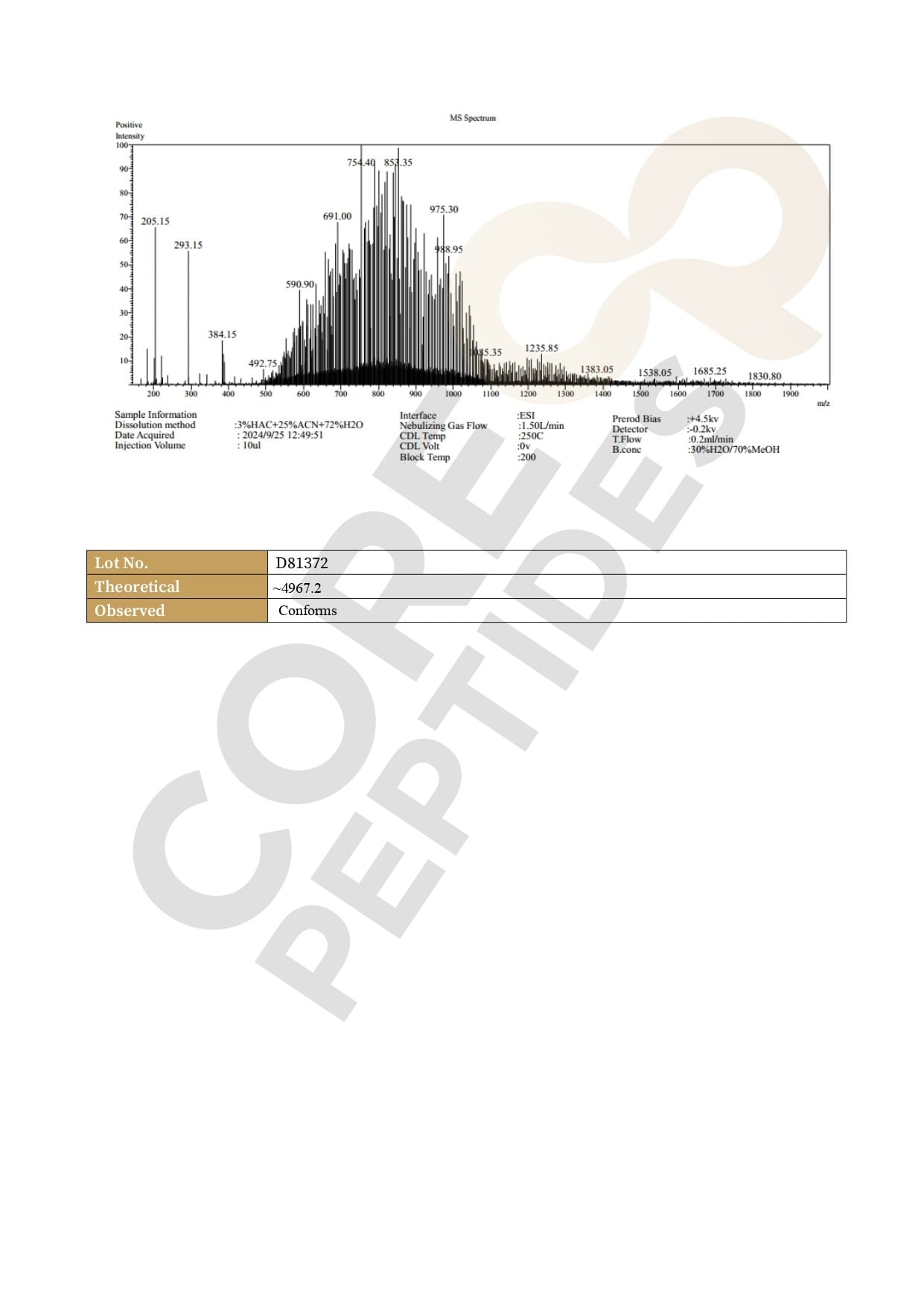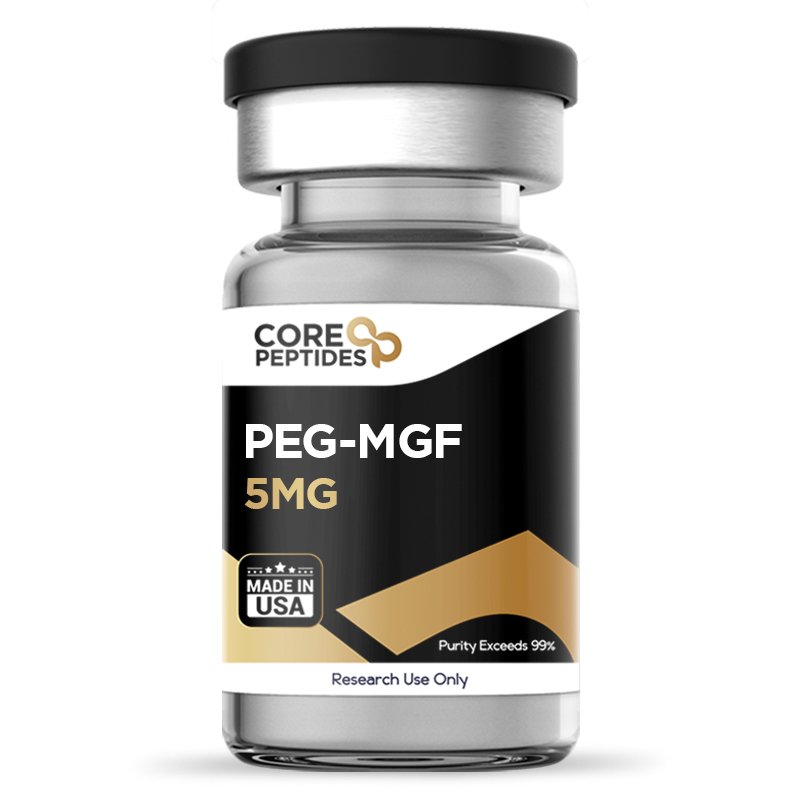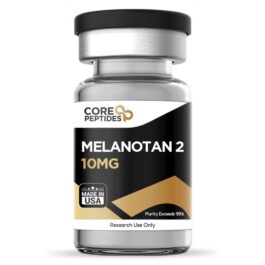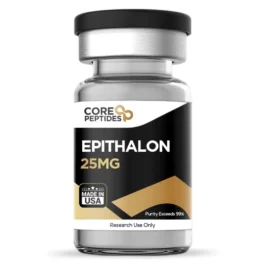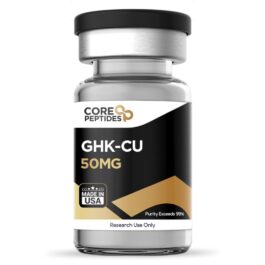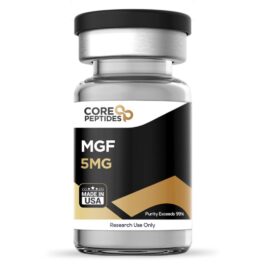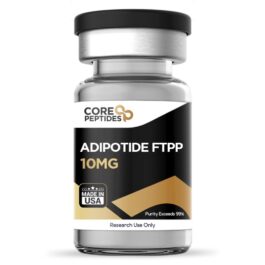PEG-MGF (5mg)
$63.00
Size: 5mg
Contents: PEG-MGF (5mg)
Form: Lyophilized powder
Purity: >99%
SKU: P-PEGMGF-5
FREE Shipping on $200+ orders
Discount per Quantity
| Quantity | Discount | Price |
|---|---|---|
| 5 - 8 | 5% | $59.85 |
| 9 + | 10% | $56.70 |
PEG-MGF Peptide
MGF is an acronym for Mechano Growth Factor, a research peptide that scientists consider to belong to the class of IGF-1 (insulin-like growth factor) family.(1) An isoform of IGF-1, MGF is also known as IGF-1Ec, and is believed to primarily be produced in the liver.(2) The IGF-1 gene appears to undergo transcription and may generate the three mRNA isoforms: IGF-1Ea, IGF-1Eb, and IGF-1Ec. This indicates that MGF (or IGF-1Ec) may be identical to IGF-1 but with a different E domain. Synthesis of each isoform appears to possess specific functions in different tissues as a response to diverse stimuli.
PEG-MGF, or polyethylene glycol (PEG)-ylated MGF, is a synthetic form of MGF. Pegylation connects polyethylene glycol (PEG) to another compound to alter its structure. Scientists consider that MGF by itself may have a short half-life; however, once bound with PEG, the half-life may be extended by some days.
Research studies posit that PEG IGF-1 may be more impactful than recombinant IGF-1 for muscle cell regeneration and improving muscle function. The main reasoning was attributed to the hypothesis that PEG may not easily bind with any other compounds, and may thereby lead to delayed clearance. In addition, modifying the C terminus of IGF-1 with the addition of PEG may increase the peptide's potential impact on tissues.(3)
Overview
Researchers suggested the existence of three IGF-1 precursor proteins formed upon the splicing of the mature IGF-1. Each precursor comprises 70 amino acid residues from the mature IGF-1, and may only differ in the amino acid sequence attached to the COOH terminal, possibly determining its function. During the late 1990s and early 2000s, it was suggested that one of the three precursors, IGF-1EC (MGF), may increase upon muscle injury.(4)
Several studies have been carried out thereafter(3) to isolate and synthesize the (PEG)-ylated MGF to modify and potentially improve the impact and action of the peptide. The studies have suggested that under muscle stress the mature IGF-1 may become spliced as a response to stress and may thereby produce and release one of the isoforms called IGF-1EC, also known as Mechano Growth Factor (MGF).(4)
One research hypothesis suggests that as MGF increases, the amino acid sequence attached to the COOH terminal of MGF may become activated and promote cell proliferation in muscle stem cells. Further studies indicated that PEG-MGF may stimulate the proliferation of C2C12 muscle cells and myoblasts upon presentation. Based on these results, it was suggested that the MGF peptide may be biologically active and inert by nature. PEG-MGF may induce stronger, more durable action of normal MGF.
Chemical Makeup
Molecular Formula: C121H200N42O39
Molecular Weight: N/A
Other Known Titles: PEG-MGF-E, PEG-MGF-Ct24E
Research and Clinical Studies
PEG-MGF Peptide and Muscle Structure
Muscle resistance activity seems to activate mechano-growth factor (MGF) mRNA in muscle tissues, which researchers suggest manifests as a substantial 163% rise from baseline levels.(5) This pronounced increase suggests a potentially direct response of MGF to mechanical stimuli within the muscles. Concurrently, an observed surge in growth hormone levels, which typically accompanies muscle resistance, may add complexity to this molecular interplay. Data suggests a 456% augmentation in MGF mRNA coinciding with resistance activities, whereas an increase in growth hormone levels alone appears to influence MGF mRNA expression by about 80% compared to baseline. The scientists commented “This may reflect an overall up-regulation of transcription of the IGF-I gene prior to splicing.” Consequently, it is hypothesized that MGF may play a critical role in the organism’s intrinsic mechanism to mitigate muscle damage and promote tissue repair in response to mechanical stress. This hypothesis underscores the intricate and coordinated molecular responses triggered by physical exertion, reflecting a sophisticated biological adaptation to preserve muscle integrity and function.
To further investigate this, a study(6) was conducted to examine the potential of MGF on muscle repair and wound healing. Experimental murine models induced with muscle contusion and muscular macrophage depletion were used as study subjects. Based on comprehensive analyses following the study, the researchers theorized that MGF might induce muscular repair in the wounded tissues. MGF appeared to decline the rate of fibrosis in the contused muscles and reduced the expressions of inflammatory cytokines, chemokines, and stress factors. Preliminary analyses indicated that MGF might affect fibrosis in damaged muscle tissue through the likely suppression of collagen types I and III expression. These collagens are considered essential components of the extracellular matrix involved in fibrotic processes. Additionally, there appeared to be a noticeable decrease in oxidative stress markers and matrix metalloproteinases (MMPs), which might suggest that MGF may attenuate certain inflammatory processes associated with muscle injury. Moreover, the prevalence of contused muscles seemed to decrease, potentially facilitating the repair mechanisms in the injured tissues. The investigation also proposed that MGF's influence on the functional dynamics of satellite cells post-injury and immune cell presence at the injury site—both deemed critical to muscle regeneration—might be minimal. This proposition is based on the stable expression levels of MyoD and myogenin, which are considered to be pivotal markers of satellite cell proliferation and differentiation, respectively. Therefore, while MGF may alleviate some facets of the muscle injury response, its direct impact on satellite cell functionality in these specific circumstances may not definitively be established. The study further suggested that MGF might modify the inflammatory environment within the injured muscle tissue. This modulation is tentatively evidenced by a reported decrease in the expression of pro-inflammatory cytokines such as tumor necrosis factor-alpha (TNF-α), interferon-gamma (IFN-γ), interleukin-1 beta (IL-1β), and transforming growth factor-beta (TGF-β), alongside chemokines like CCL2, CCL5, and CXCR4 following MGF experimentation. Additionally, there was a speculative indication that MGF might help mitigate oxidative stress in injured muscles, as suggested by a possible reduction in the expression of gp91phox, an element of NADPH oxidase that appears to play a significant role in the generation of reactive oxygen species.
PEG-MGF Peptide and Cardioprotection
The main goal of this study(7) was to evaluate the potential of MGF action on cardiac muscles undergoing programmed cell death following hypoxia, a condition characterized by limited supply of oxygen. Rats were experimentally induced with hypoxia with only 1% oxygen supply, leading to cellular apoptosis. Once the peptide was given to the rat models, the study reported that the peptide appeared to induce increased migration of stem cells to the heart, possibly leading to apoptosis inhibition. More specifically, MGF is suggested to potentially enhance the migration of mesenchymal stem cells (hMSCs). This process suggests a chemotactic action, which may be strategically employed to guide stem cells to areas affected by injury or disease. The basis for this proposition stems from apparent increases in the levels of the Bcl-2 gene, which is believed to play a critical role in enhancing cell survival, thus suggesting that MGF may possess qualities that inhibit apoptotic processes in cells. This observation underscores the possibility of MGF as a potential agent in enhancing tissue regeneration by modulating cellular mechanisms that may prevent programmed cell death.
PEG-MGF Peptide and Bone Fracture
The main goal of this study(8) was to evaluate the potential of MGF on bone injury. 27 rabbits were experimentally induced with a 5-mm bone defect and were then divided into three groups that were given MGF, or a control substance for 5 consecutive days. Post-trial, when the bone tissues were histologically examined, the researchers reported that the control tissue appeared to be the least healed, whereas the bone tissue with MGF appeared to be the most healed. Comparatively, MGF-exposed tissues also exhibited a superior healing process relative to those exposed to Insulin-like Growth Factor 1 (IGF-1), suggesting that MGF may interact with cellular processes in a distinct manner from IGF-1. Further insights from the study suggest that MGF might influence the cell cycle by potentially halting it at specific stages, and it may also activate the Mitogen-Activated Protein Kinase/Extracellular Signal-Regulated Kinase 1/2 (MAPK-Erk1/2) signaling pathway. These mechanisms indicate that MGF might employ a multifaceted strategy to enhance cell proliferation, which likely involves altering cell cycle progression and triggering particular molecular pathways crucial for cellular repair and regeneration. This nuanced approach underscores MGF's potentially complex and targeted action in bone healing models.
PEG-MGF Peptide and Neuroprotection
Several studies(9) were conducted on mice who were experimented on in order to increase the levels of MGF and thereby study the action of increased MGF concentration on their brain cells. One study included the breeding of mice to constitutively overproduce MGF in the hippocampus area of the brain. The hippocampus is considered primarily responsible for regulating the neurogenesis phenomenon in the body. This overproduction of MGF appeared to result in high concentrations of BrdU, a biological marker representative of proliferative action. Another study was conducted where mice were bred to conditional MGF production at 1, 3, and 12 months old. Behavioral analysis and biological responses were examined after 2 years. These mice were reported to exhibit elevated levels of BrdU and neurogenesis.
MGF Peptide and Muscle Tissue Hypertrophy
The main aim of one pivotal study on MGF(10) was to assess its potential on muscle cells of varying ages. In this study, muscle cell cultures, from neonatal to aged stages, underwent evaluation after being exposed to MGF. It was observed that in younger cells, MGF seemed to postpone the onset of cellular senescence, which is the gradual deterioration of cellular function. This delay suggests that MGF might be able to maintain muscle function and its regenerative properties, which typically decline with age. Additionally, the study noted an enhancement in cell proliferation among cells ranging from neonatal to young; however, such proliferation did not appear to extend to the older aged cells. In these older cells, there was a noticeable increase in muscle hypertrophy, characterized by an augmented muscle cell size. Yet, there was a marked reduction in the number of reserve cells. These reserve cells, which typically do not immediately differentiate or amalgamate into myotubes, were apparently at a reduced proportion in the culture. Myotubes, crucial structures in muscle development, are formed through the fusion of muscle cells. This fusion process was apparently enhanced across all age groups by MGF, which not only increased the myotube size but potentially also the muscle’s functional capabilities through the augmented expression of muscle-specific contractile proteins. This observation is significant as it implicates a reduced presence of reserve cells, suggesting that MGF might encourage these cells to participate more actively in muscle formation. In conclusion, the researchers posited that “MGF-24aa-E peptide alone has a marked ability to enhance satellite cell activation, proliferation and fusion for muscle repair and maintenance.”
PEG-MGF is available for research and laboratory purposes only. Please review and adhere to our Terms and Conditions before ordering.
References:
- Philippou A, Papageorgiou E, Bogdanis G, Halapas A, Sourla A, Maridaki M, Pissimissis N, Koutsilieris M. Expression of IGF-1 isoforms after exercise-induced muscle damage in humans: characterization of the MGF E peptide actions in vitro. In Vivo. 2009 Jul-Aug;23(4):567-75. https://pubmed.ncbi.nlm.nih.gov/19567392/
- Zabłocka, B., Goldspink, P. H., Goldspink, G., & Górecki, D. C. (2012). Mechano-Growth Factor: an important cog or a loose screw in the repair machinery? Frontiers in endocrinology, 3, 131. https://www.ncbi.nlm.nih.gov/pmc/articles/PMC3485521/
- Janssen, J. A., Hofland, L. J., Strasburger, C. J., van den Dungen, E. S., & Thevis, M. (2016). Potency of Full-Length MGF to Induce Maximal Activation of the IGF-I R Is Similar to Recombinant Human IGF-I at High Equimolar Concentrations. PloS one, 11(3), e0150453. https://www.ncbi.nlm.nih.gov/pmc/articles/PMC4798685/
- Rotwein P. (2014). Editorial: the fall of mechanogrowth factor?. Molecular endocrinology (Baltimore, Md.), 28(2), 155–156. https://www.ncbi.nlm.nih.gov/pmc/articles/PMC3896639/
- Hameed M, Lange KH, Andersen JL, Schjerling P, Kjaer M, Harridge SD, Goldspink G. The effect of recombinant human growth hormone and resistance training on IGF-I mRNA expression in the muscles of elderly men. J Physiol. 2004 Feb 15;555(Pt 1):231-40. doi: 10.1113/jphysiol.2003.051722. Epub 2003 Oct 17. PMID: 14565994; PMCID: PMC1664832.
- Liu X, Zeng Z, Zhao L, Chen P, Xiao W. Impaired Skeletal Muscle Regeneration Induced by Macrophage Depletion Could Be Partly Ameliorated by MGF Injection. Front Physiol. 2019 May 17;10:601. https://pubmed.ncbi.nlm.nih.gov/31164836/
- Doroudian G, Pinney J, Ayala P, Los T, Desai TA, Russell B. Sustained delivery of MGF peptide from microrods attracts stem cells and reduces apoptosis of myocytes. Biomed Microdevices. 2014 Oct;16(5):705-15. https://pubmed.ncbi.nlm.nih.gov/24908137/
- Deng M, Zhang B, Wang K, Liu F, Xiao H, Zhao J, Liu P, Li Y, Lin F, Wang Y. Mechano growth factor E peptide promotes osteoblasts proliferation and bone-defect healing in rabbits. Int Orthop. 2011 Jul;35(7):1099-106. https://pubmed.ncbi.nlm.nih.gov/21057789/
- Alec Walker. Hearts and Minds of Mice and Men: Mechano Growth Factor a new tool in the battle against age-related neuron loss? 20 Jul 2017.
- Kandalla PK, Goldspink G, Butler-Browne G, Mouly V. Mechano Growth Factor E peptide (MGF-E), derived from an isoform of IGF-1, activates human muscle progenitor cells and induces an increase in their fusion potential at different ages. Mech Ageing Dev. 2011 Apr. https://pubmed.ncbi.nlm.nih.gov/21354439/
